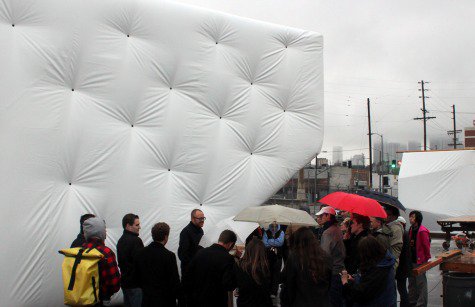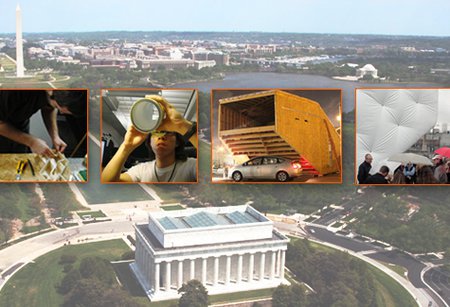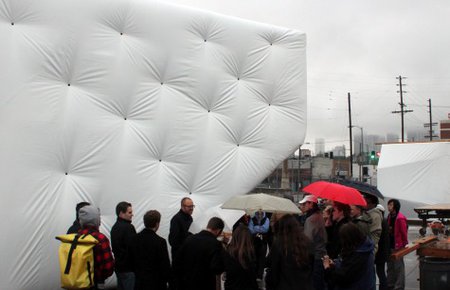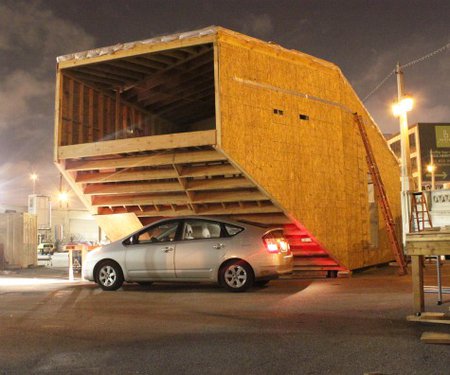Thanks to a campaign led by a joint team of students from Caltech and the Southern California Institute of Architecture (SCI-Arc), the 2011 Solar Decathlon is back on the National Mall in Washington, D.C. The announcement made last week reverses an earlier decision by the U.S. Department of the Interior (DOI) to relocate the event.
The two-week competition, taking place in the fall, will now be held in West Potomac Park, on a swath of land between the Lincoln and Jefferson Memorials. "Everyone's relieved and happy that we're back on the Mall," says Caltech's Fei Yang, a senior majoring in mechanical engineering, and one of the leaders of the SCI-Arc/Caltech team.
The biennial competition, sponsored by the U.S. Department of Energy (DOE), invites 20 teams from around the world and challenges them to build the most energy-efficient, affordable, and attractive house they can. All four previous competitions have taken place on the National Mall—between the Capitol and the Washington Monument—providing a high-profile venue to inspire policymakers, industry leaders, and the public to pursue a sustainable future with state-of-the-art design and technology.
But in January, the DOI, with the approval of the DOE, decided that the event could no longer be held on the Mall, citing the need to protect and preserve the grounds. "It came as a shock," Yang says.
A statement posted January 11 on the DOE Solar Decathlon website noted that the decision to change locations was made "in support of the historic effort underway to protect, improve, and restore the National Mall." The DOI is embarking on a $600 million plan to renovate the grounds and areas around the monuments. But this justification didn't make sense, says Elisabeth Neigert, a recent SCI-Arc graduate and one of the project managers for the SCI-Arc/Caltech team; a clause in each team's contract already makes them financially responsible for any damage.
Furthermore, Neigert says, this sudden change in venue was made three-quarters of the way through the competition, after design, engineering, and logistical decisions had been made based on the expectation that the house would be built on the Mall. And the promise of high-profile exposure was crucial in securing sponsors. "This late in the game, it left us in a really difficult position," she says.
"They tore the heart out of the Solar Decathlon," says Cole Hershkowitz, also a Caltech senior in mechanical engineering and another leader of the team. "One of the reasons why the competition is so prestigious is because the government supported it and it's in arguably the most prominent place in our country, right there between the Capitol and the Washington Monument." There's no monetary prize for the winner, so the prestige and the opportunity to showcase their innovations are the teams' rewards. "If we had known that it would not be on the National Mall, I think only half of us would've applied," Hershkowitz says.
What followed was a concerted effort led by Neigert and the SCI-Arc/Caltech team to appeal the DOI's decision. Working with the other 19 Solar Decathlon teams, the group of architecture and engineering students suddenly found themselves in the middle of a political campaign. After much lobbying, they received support from organizations such as the National Coalition to Save Our Mall. They also got official backing from more than a dozen senators and other congressional leaders, including California senator Barbara Boxer and Massachusetts representative Edward Markey, ranking member of the Natural Resources Committee.
Then, the Washington Post stepped in to cover the debate, and Neigert and Eric Owen Moss, director of SCI-Arc, penned opinion columns for the Huffington Post. Two days after the op-eds appeared—and after six weeks of relentless campaigning—the DOI reversed its ruling. "I was filled with disbelief, but I was also absolutely elated," Neigert says. "I was pretty speechless, which doesn't happen very often." Even though the event would no longer be right in front of the Capitol steps, the team is satisfied. "It was probably the best outcome we could've gotten, given the circumstances," she says.


Now, the team can refocus on building their house, which is computerized to control and monitor energy usage to maximize efficiency. Every house in the competition is required to be net-zero—that is, to use only as much energy as its solar panels can generate. But perhaps what's most striking about the SCI-Arc/Caltech design is its soft, insulating exterior, which gives the building the appearance of a giant pillow. The house is also the only two-story structure in the competition.
With the Solar Decathlon back on the Mall, the team hopes their design will attract plenty of eyes. After all, from historic moments like Martin Luther King's "I Have a Dream" speech to the numerous festivals that attract hundreds of thousands of visitors, the National Mall is a place where things happen and are noticed, Hershkowitz says. "What makes the National Mall so iconic is not how green the grass is, but the quality of events."
The SCI-Arc/Caltech team will hold a groundbreaking event on April 2 at the SCI-Arc campus in Los Angeles.

 The full-sized model of the SCI-Arc/Caltech house with its soft, insulating exterior.
The full-sized model of the SCI-Arc/Caltech house with its soft, insulating exterior.
 A full-sized model of the SCI-Arc/Caltech house.
A full-sized model of the SCI-Arc/Caltech house.
